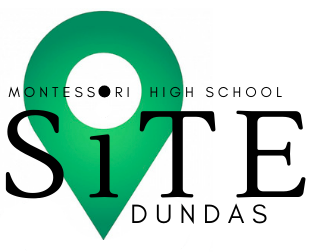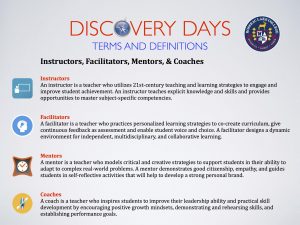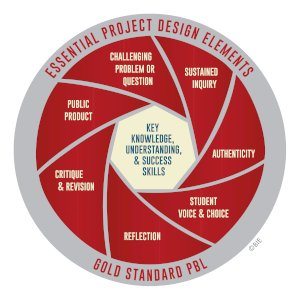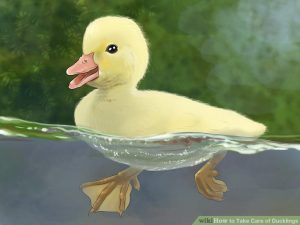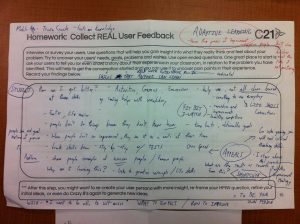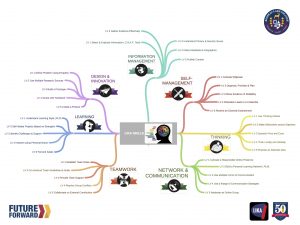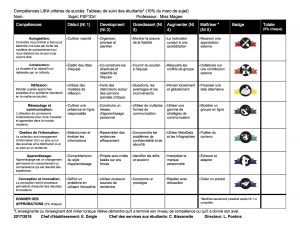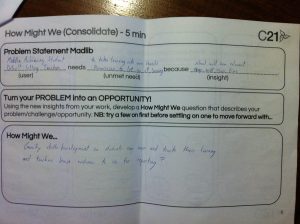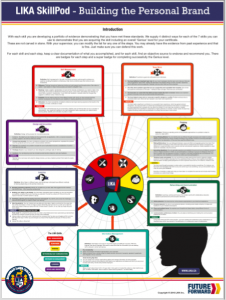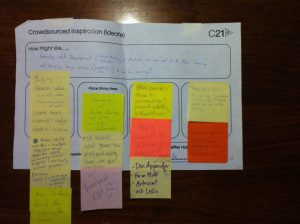For those of you unfamiliar with the brainstorming and iterative process known as Design Thinking, one of its most beneficial takeaways comes in the formation of what is called a HOW MIGHT WE question. This simple but profoundly empathetic injunction really gets the creative juices flowing; it can help to organize an action plan, kickstart an entrepreneurial endeavour, or overhaul a stale vision, allowing everyone involved—from the financial team to the end product user—to imagine new possibilities in solving tough challenges and addressing needs. What started as an esoteric creative process amongst designers and engineers, eventually made its way to Stanford University education research and into the popular imagination. Shows like Netflix’s ABSTRACT, showcase the influential power design has as an integrative discipline, continuously pushing the boundaries between art and science, psychology and business, math and philosophy.
What we’ve found is that kids are especially good at following the critical and creative stages of a Design Thinking process (it mirrors their natural curiosity and hands-on experimenting instinct); perhaps why the Design Thinking mindset has particularly benefitted inquiry-based approaches, PBL, Makerspace, and STEM or STEAM prototyping programs in school systems around the world.
For educators, Design Thinking is an especially powerful tool for professional development (Cohort21 spends the bulk of its workshop facilitation on an action plan based around this process) because our world has changed so rapidly in the past few decades, the importance of innovation in education has risen to become a top priority in both public and private systems. Simply put, schools can’t afford to disengage the next generation of students into what should be their human right: a profound sense of discovery through the power of learning. We know this personalized discovery process is no longer served by traditional factory models, over-stuffed classrooms, and out-dated academic achievement-only environments. It is up to every single teacher, administrator, and education system to recognize the various disconnects in their models and redesign unique and sustainable ways to improve. Innovate or die, as the saying goes.
A HOW MIGHT WE question has at its root, all the ingredients needed to establish an environment of inventiveness and openness. The question HOW is a practical extension of WHY and forces the dreamer into more utilitarian ways of problem solving, through constraint. The MIGHT ensures this is an iterative process, of countless prototyping and drafts, of formative experimentation that, yes, may indeed lead to failure (or new ways of looking at the same old!). There is resilience in MIGHT, adaptability in MIGHT, but also a positive desire and hope for change. Finally, there is the necessary WE. Collaboration and diverse perspectives are key to any successful venture. Empathizing with your end user ensures an ability to radically alter, if need be, the purpose and outcome of the change itself. If an idea is sometimes referred to as a “baby”, than it truly takes a village to innovate one.
Which brings me to my current challenge. I’ve co-founded a school named SiTE (Situated in Transformative Environments): a Montessori high school in Dundas, Ontario. Thankfully, my co-founder, Tony Evans, 18 years ago established an unbelievable community of progressive parents and self-directed children through his two other high-fidelity Montessori schools, Dundas Valley Montessori School, and Strata Montessori Adolescent School. Why Dundas? Here is one reason:
As with any new venture that is already up and running (10 courageous students started learning with me on September 3), we don’t have the luxury of prolonged research and development phase—we are iterating on the fly! At a recent international adolescent Montessori workshop (AMI/NAMTA) I attended in North Carolina, I was reminded just how bold an endeavour SiTE Schools is when out of a group of 100 Montessori educators, only one other school had extended their program to encompass Grade 10, 11, and 12 (Academy of Thought & Industry). In fact, when I researched Canadian Montessori high schools in the Our Kids website, I found only a half-dozen schools even attempting to tackle the senior secondary years in an authentic Montessori-style, and all of them are operating from an actual building! Have I got your attention yet?
Here is a highlight reel of the many many HOW MIGHT WE questions I’m wrestling with as I venture upon the greatest challenge of my professional career:
- How might we create an adolescent Montessori micro-school without a traditional bricks & mortar building?
- How might we use our unique small-town environment as flexible learning spaces that enhance subject mastery?
- How might we partner with local business, galleries, Universities, to co-create real-world projects?
- How might we reimagine the idea of teenagers and community for the 21st century?
- How might we create a flexible timetable that starts at 10:00 and revolves around opportunities for outdoor and experiential learning?
- How might we create a “quest-like” block course calendar where students immerse themselves in single subject areas for a concentrated period of time?
- How might the daily timetable be self-directed?
- How might we create a school of experience instead of a school of compliance?
- How might we bring dignity to adolescence?
- How might we enhance student initiative through purposeful work and meaningful context?
- How might we track students or take attendance when the entire community is your campus?
- How might we establish a tuition that is equitable and competitive?
- How might we teach all three senior levels (Gr 10, 11, 12) at the same time?
- How might we have one teacher to curate all subject material and use a team of experts to facilitate skill-building?
- How might we turn every single assignment into either a group or independent inquiry project?
- How might we create a “living curriculum” based on the personal interests of each student and the changing needs of the community?
- How might we co-construct curriculum with students and still achieve ministry expectations?
- How might we use socratic seminar (discussion and debate) for every lesson?
- How might we use ONE single-point rubric to assess ALL assignments within a course?
- How might we use an ongoing standards-based gradeless assessment?
- How might we becomes guides instead of teachers, curators instead of facilitators, advisors instead of mentors?
- How might we market the school with full parent/student participation?
If any of these questions relate to areas of interest you are currently considering developing in your school, let’s talk. Please consider your sphere of influence (Garth will talk about this at our 2nd F2F). I am grateful to be tackling the teaching opportunity of a lifetime and am ready and willing to be the guinea pig for all manner of educational innovation and disruption.
But I can’t do it alone. Nor do I need to.
Cohort21, developed 8 years ago as a CISOntario incubator for 21st century PD, is a vibrant community of innovative educators who have greatly helped me these past four years develop into the disruptor I feel I was destined to be. @gnichols has mentored me through some profound life changes, guiding me towards embracing the positive inventiveness he demonstrates daily at Havergal College. @jmedved is a beacon of innovation, always rethinking the HOW from his York School perch. @ckirsh has pushed me to question ethical choices and even challenged my MIGHT to join her podcast. @gvogt is my doppelgänger, a fellow poet of pedagogy in a sea of disruptive potential. No other person could have helped steward the Discovery Day initiative at Rosseau Lake College, making it even more engaging and sustainable. @lmcbeth is the queen of Design Thinking and through her work with the Future Design School has greatly shaped how I view education and entrepreneurship. @lbettencourt and @adamcaplan will trial anything tech in the most transparent of ways, sharing as they fail forward. @nblair is my spirit guide when it comes to questioning the status quo—no one does it better or with more grace.
There are more. Too many to mention here. Past facilitators, current coaches, former colleagues, and alumni galore. Cohort21 has a treasure trove of action plans at your disposal to pillage and plunder as you formulate your own powerful HOW MIGHT WE. Make sure to steal like an artist.
Folks, this is your village, this is your WE.

